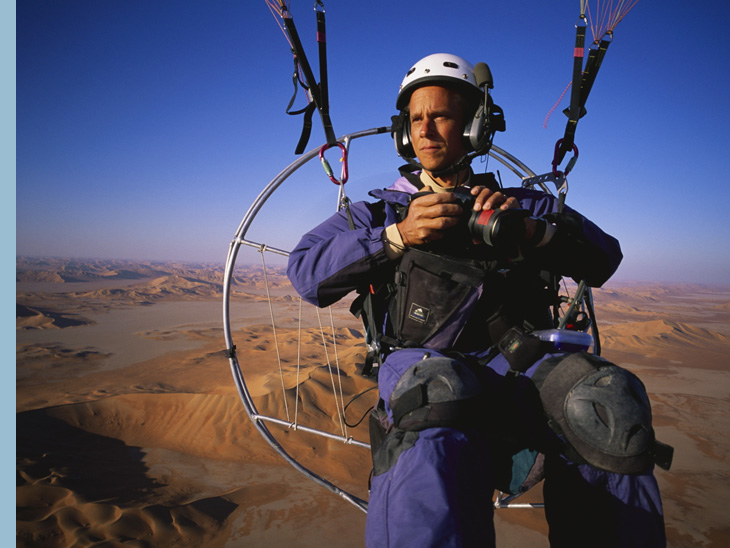SEEN FROM ABOVE
The impressive thing about George Steinmetz’ (1957) photographic work is its unique perspective — from above. National Geographic's top expedition photographer admits that even he can get a bit unhinged by the dizzying heights he attains in the man-in-the-flying-machine contraption — a motorized paraglider — he uses to photograph places inaccessible by traditional aircraft. On a typical workday, George Steinmetz rises before the sun. He ventures outside to greet the most desolate and vast places. The high-flying adventurer began his unique brand of flying in 1997 in order to get aerial images of these remote landscapes, many of which are only accessible by this method of flying where he can take off and land without an airfield or government restrictions. Steinmetz soars at 30 miles per hour in the open air above windswept dunes and stony vistas for up to three hours, capturing the enormity of nature over the most remote and inhospitable places on earth from a bird’s-eye view with his camera. His restless curiosity for the unknown drove him to hitchhike across Africa as a young man and has been the drive behind his epic body of work which covers not only remote landscapes but also climate change and global food supply. He has also been arrested many times, but his photographs have become a record of time and place, a photographic record of our planet in the anthropocene age.
It's not really an open secret when I say I have a penchant for deserts. This great fondness was nurtured in my twenties when I traveled with a good friend from Sousse via Tozeur to Douz, in southern Tunisia. Douz is a palm oasis village southeast of the beautiful salt lake Chott el Djerid (used as a filming location for the domed Lars Homestead from Star Wars in 1976) and is considered the gateway to the Sahara. From this Lagoon of the Land of Palms we explored a very small part of the vast Sahara via a camel ride at temperatures around 50°C. After that I bought several books about deserts and Bedouins and traveled several more times to deserts like the Sinai in Egypt, Wadi Rum in Jordan, the Arabian Desert in Yemen and Tassili n'Ajjer in Algeria. Stimulated by the remoteness of the latter, I began to look for new challenges.
Unfortunately it only stayed with that search and I never got to the destination I subsequently found, namely the Tibesti Mountains, a group of volcanoes that form a mountain range in the Sahara in northern Chad. This mountain range is also the highest point in both Chad and the Sahara. But this search was most certainly not in vain, as it brought me to know George Steinmetz's stunning photographs. The breathtaking photo report about Chad, which appeared in a copy of National Geographic magazine I borrowed back in 2012, triggered me to learn more about this photographer.
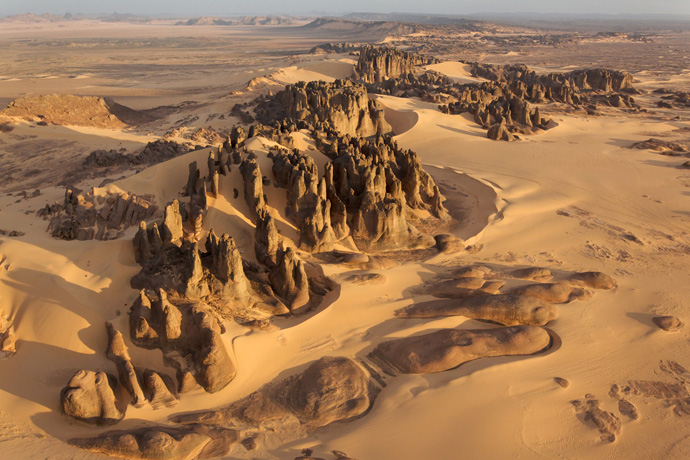
Inakashaker (named after a kind of locally-found bush in Tuareg language), where time and wind-blown sand have sculpted ancient sediments into fantasical forms. This area of beautifully eroded rocks is a five-hour drive from Tamanrasset, in the Tassili du Hoggar, yet another desert place on my list.
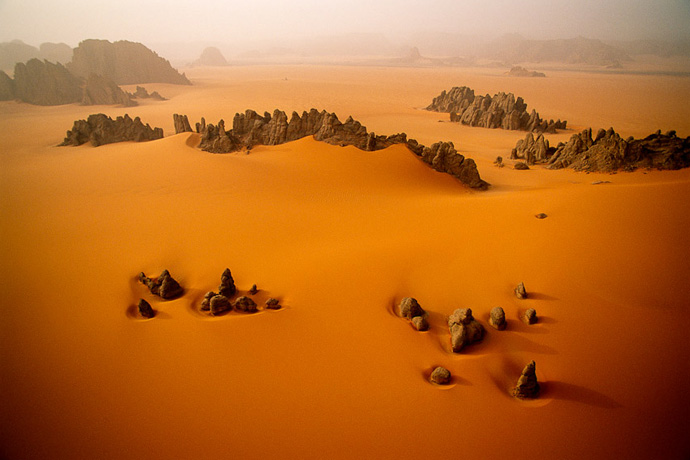
When Steinmetz picks a place to photograph, he's usually driven by curiosity and a hunch more than real intel. In the case of his expedition into the Karnasai Valley of Chad, even satellite photos of the area were few and far between; frequent sandstorms and heavy haze meant that finding clear, aerial photos was all but impossible.
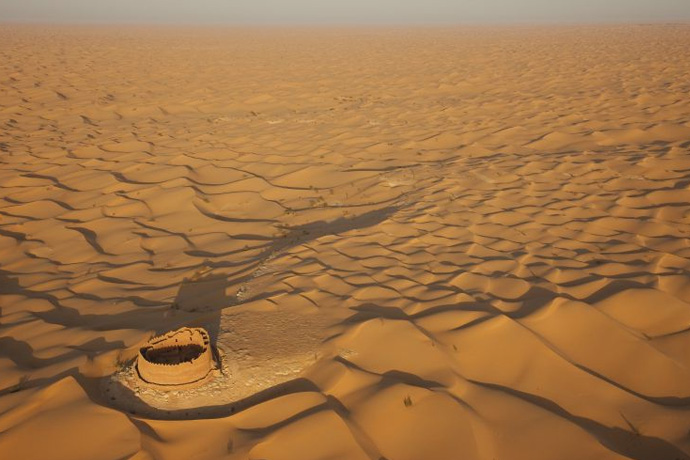
An abandoned ksar, or fortified village, keeps a lonely vigil in the barren landscape of the Grand Erg Occidental, Algeria. This ksar was made with stones rather than mud brick. It is unusually well preserved, and all that remains of at era that was once verdant enough to support human settlement.
"Nobody was really looking at these places. They're wastelands; who would want to go there, right? But from the air, these places are really spectacular and to me it opened up a part of the world that most people hadn't really looked at." — George Steinmetz
HITCHHIKE ACROSS AFRICA | A life-changing trip
Beverly Hills-born, New-Jersey-based George Steinmetz is an adventurer in every sense of the word. He first discovered his love for photography as a geophysics student at Stanford University. In 1979, at age 21, he took time off to spend 28 months hitchhiking around Africa with a borrowed camera in hand. His parents didn't want him to go, so he used all his savings, earned from all sorts of vacation jobs, and traveled to the continent where he survived on just $5,000. He wanted to understand Africa more deeply so on site had to learn French, Swahili and a little bit of Arabic with a small dictionary at hand. Growing up with National Geographic as a kid, he wanted to take beautiful pictures too. He later commented in an interview that he had taken a lot of bad photos then, partly because he could only see the result much later after his photos were developed on the home front.
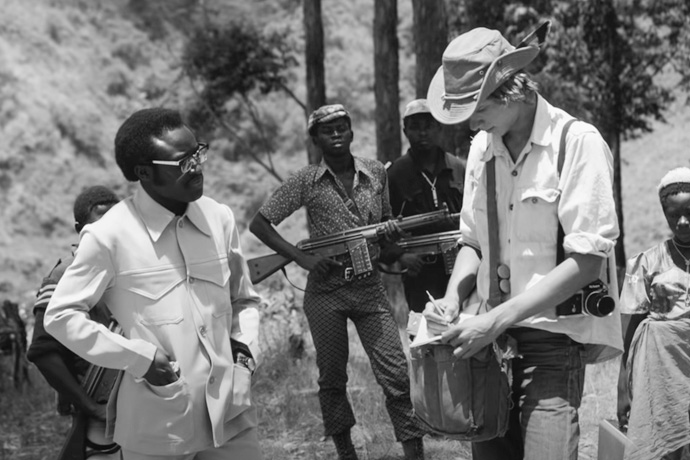
Young George Steinmetz started to pretend he was working for National Geographic. He also thought it was cool to have a camera with him. It gave him an excuse to explore things.
When Steinmetz returned to the US, he did not immediately find a job because his portfolio was not relevant enough. After some searching he became a photographer's assistant in California and mainly learned what he didn't want to do; he didn't want to do studio work, still life or ads. After two years he started to work independently as a portrait photographer. He made portraits of Steve Jobs and Bill Gates, among others, but his work quickly evolved into reportage photography.
"I always want to go to the blank spots on a map, or go just a little bit farther. Reality is always more interesting than imagination. To be honest, it's a big pain. But, you see, I'm the only one who takes pictures like this." — George Steinmetz
A FLYING LAWN CHAIR | Be careful not to get your knees in the picture
Steinmetz started taking aerial photos from a Cessna plane with no side door, but it had to fly at a certain height, at too high a speed, while he sat next to an open gaping hole. He wanted to be able to move across parts of the Sahara where no one had been before. So he was searching for a new way of looking at desert environments. Then, in 1997, he pitched to take aerial photographs of the Central Sahara at the National Geographic magazine. He received a budget but his bush pilot backed out. Nobody else could be hired to fly in Niger and there were only helicopters belonging to the French military in Chad, so Steinmetz decided to learn to fly himself, taking lessons in motorized paragliding, which does not require a pilot's license, in an Arizona desert.
To get aloft in such remote places he used the lightest and slowest aircraft which he pilots while taking pictures. His own ‘flying garden chair’: it consists of a nylon paraglider, a harness, a tank of gas and a backpack-mounted motor with a large propeller that looks like an industrial fan. His body became the fuselage. He described it as a “leaf blower with a parachute overhead.” A few months later, he bought his own gear and was sailing above salt caravans in Niger.
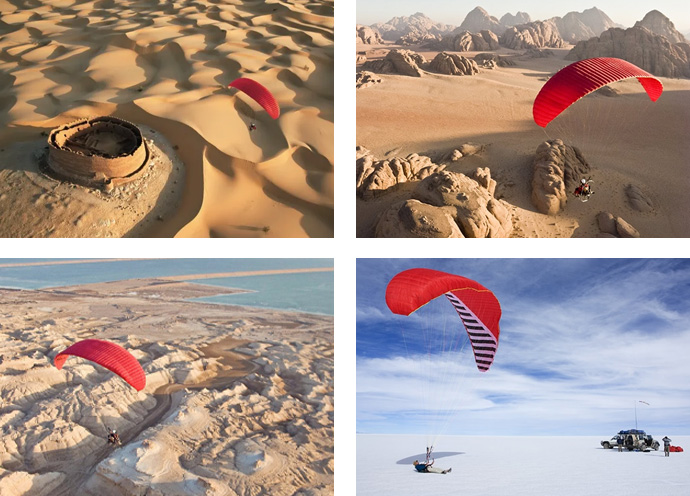
To lift off, he spreads the glider on the ground, cranks up the motor and runs a few steps when the right gust of wind comes along. He pioneered the use of this foot-launched motorized aircraft that gave him the ability to see these seldom visited areas in a way that has never been realized before. Traveling 30 miles per hour, and 180-degree horizontal and vertical visibility, this experimental aircraft enables him to capture unique images of places inaccessible by traditional aircraft and most other modes of transportation. It's a very personal kind of aerial photography, because there's no barrier between him and the outside.
Dangling from a paraglider with a propeller on his back, Steinmetz gets a new perspective on Africa. In the next decade he flew over some of the world's most forbidding places, a flamboyant red blip against the clouds. Most aerial photographers work from helicopters or little planes, but he went up on this crazy little thing and flow very low, so he could photograph people in the landscape. Sometimes, when he was flying at a height of about 100 feet, he was terrified. He found that once he focused on taking pictures, he stopped thinking about dying and calmed down. It helped to think about things he could control. It's very, very dangerous work, but in my humble opinion with breathtaking results.
"I had a lot of unusual experiences flying in very rare places — like getting caught in sandstorms, some bad crashes. You have a lot of really epic moments where you see things that no one's ever seen before." — George Steinmetz
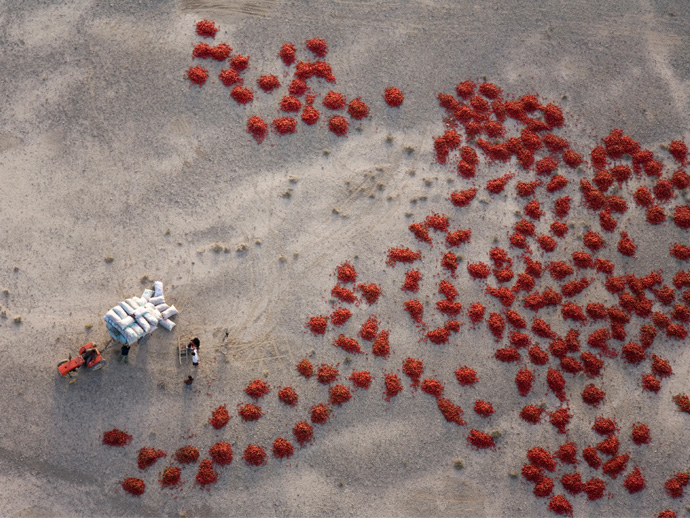
Red peppers laid out to dry on the gravel plains of the Gobi Desert, China.
From airport to airport, Steinmetz carried his personal aircraft, which could be disassembled and stashed in three bags, each weighing about 50 pounds, that he would proceed to check in. Harnessed to his stable and silent paraglider, photographer Steinmetz takes viewers on a world tour, from the Gobi desert in China and the sandy plains of the African Sahara, to the vast American deserts like Death Valley. He is fascinated with the hyper-arid regions — “areas that get less than four inches of annual precipitation.” In these sweeping orange, yellow and red landscapes, man-made structures look like small-scale models, and living things appear to be frozen figurines. Shooting deserts has been a large part of his work.
Seen from above, the world’s deserts offer astonishing compositions. George Steinmetz has hovered over them since the beginning of his career and set out to photograph all of the world's extreme deserts. He has published a number of his finest photographs in a book that is only just big enough to hold their subjects. The Desert Air project took him to 27 countries plus Antarctica over a 15-year period to create the first comprehensive photographic book on all of the world's hyper arid deserts. These include the most remote and inhospitable places on earth, from the icy mountains of the Andes to the shores of the Dead Sea, from stark Arctic terrains to the oases of the Sahara. Steinmetz ventured from the hottest place on earth, in the Afar Depression of Ethiopia, to the coldest in the Dry Valleys of Antarctica.
"I see the world not only through the eyes of an artist but also a scientist. I quickly learned that these ‘barren wastelands’ are actually extremely fragile ecosystems undergoing rapid change. I didn't really set out to be an environmentalist, I was just a young guy who was curious about the world. Some of these pictures were taken years apart but you start connecting the dots and the larger impact of humans on the planet becomes apparent." — George Steinmetz
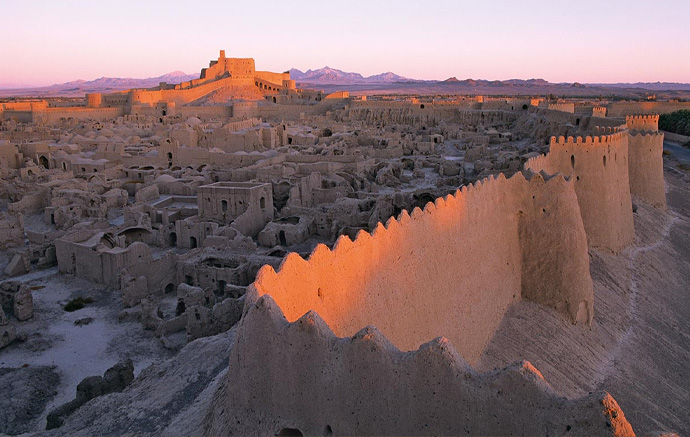
In 2003, two weeks after Steinmetz photographed the historic Bam citadel (Arg-e Bam) in Iran — the largest adobe building in the world — it was almost completely destroyed by a devastating earthquake that cost the lives of around 20,000 people.
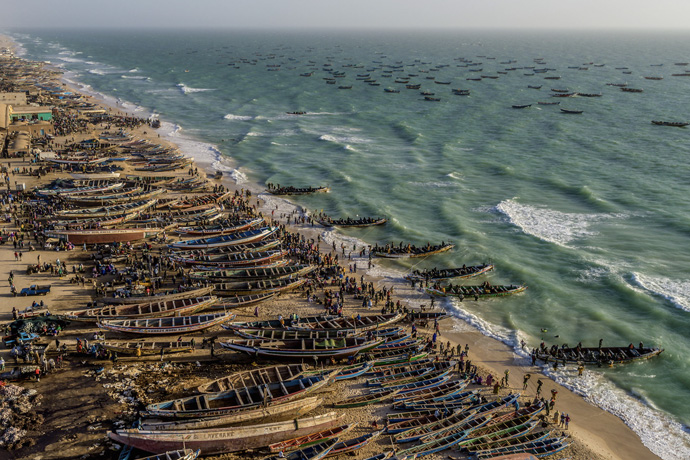
Artisanal fishing boats offloading their catch on the beach of Kayar, Senegal. Most of the fish appeared to be small pelagic fish such as sardinelle and mackerel. The small pelagic fishery has been migrating northward some 5° every 10 years for the past few decades due to changing sea temperatures and increased fishing pressure.
THE HUMAN PLANET | The accidental environmentalist
George Steinmetz’s bird's-eye view serve also as a reminder of what is happening right now. The photographer didn't intend to document climate change, but his archive of work made humanity's footprint undeniable. The New York Times Magazine asked him to go and photograph climate change on all seven continents from the air. This question made the photographer think more globally than he tends to do. In most cases, Steinmetz researched and proposed the locations and what he wanted to shoot. He decided it would be interesting to go back through his archive and kind of reinterpret what he's been photographed for the past 30 years, looking at our fragile planet in a different way. The editors and researchers with the magazine talked to scientists to confirm that climate change had affected them. But it wasn’t always easy. He had to get there and take the photo. It was proved to be stressful. When possible, he did research and made good use of Google Earth to figure out specifically where and what he wanted to shoot. For this series Steinmetz used professional drones.
Steinmetz believes we're in a time when humans have become the dominant force in the land. He thinks it's time to reflect on what we're all doing with our lives and maybe our place in the world. And the photographer thinks his book, The Human Planet: Earth at the Dawn of the Anthropocene, brings up a lot of questions. What kind of world are we going to leave behind? But as well as seeing how fragile the earth can be, Steinmetz has learned that humans have the capacity to find solutions and live in harmony with the environment. He has photographed innovations from vertical farming — a method of growing food without soil or natural light in vertically stacked beds — to renewable energy sources such as wind turbines and solar panels. While he notes not all the solutions are perfect, he believes technologies will improve. Steinmetz hopes people realize we have to make some compromises, otherwise we are not going to have much left.
"Nothing was simple. Going on such trips would require a lot of sacrifices, such as long absences from my wife, who has a career of her own, and our young family. The proposal writing and field planning for each trip took many weeks of effort. Once I got in the field, the journey itself was even more grueling. In pursuit of these images, I went through five motors, four paragliders, and nine pairs of hiking shoes." — George Steinmetz
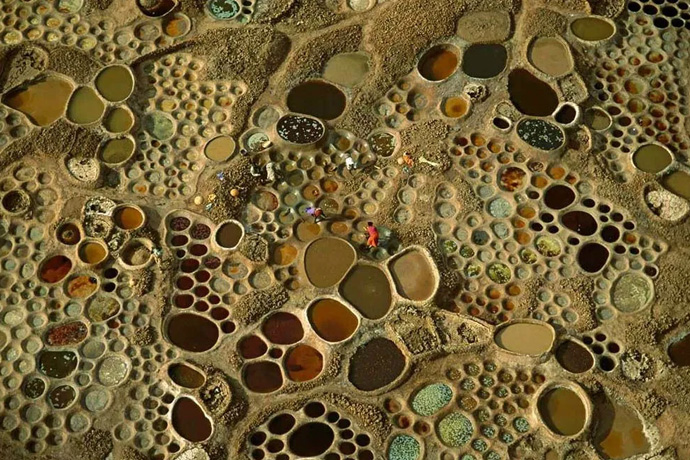
Like a mosaic laid in the hard floor of the desert, pools of evaporating salt water are worked over by the people of Teguidda-n-Tessoumt, Niger. Briny water is drawn from shallow wells and mixed with salty soil to produce slurries of different colors, whos hue depends on the color of the mud, algae, as well as the amount of salt which has hardened on the surface.
George Steinmetz became famous for his signature low-altitude aerial photography and his numerous photo reports for The New York Times Magazine, portraying unknown and hard-to-reach regions around the world. He was named National Geographic's Adventurer of the Year in 2008 and he has more than a 1 million strong following on Instagram. The documentary photographer has completed more than 40 major photo essays for National Geographic and 25 stories for GEO magazine in Germany. He has won numerous awards for photography, including three prizes from World Press Photo and the Environmental Vision award from Pictures of the Year for his work on large-scale agriculture for The New York Times Magazine. He also won two World Press Photo awards in the science and technology category.
"What I love to do is take pictures of things that people haven’t ever seen before. If I’m sitting next to someone on an airline and they open up the magazine and say ”Wow look at that!” that makes my day." — George Steinmetz
All images courtesy of the artist. Photos © George Steinmetz.
More story related movies/stories:
Related stories in Woodland Magazine:
Sources:
